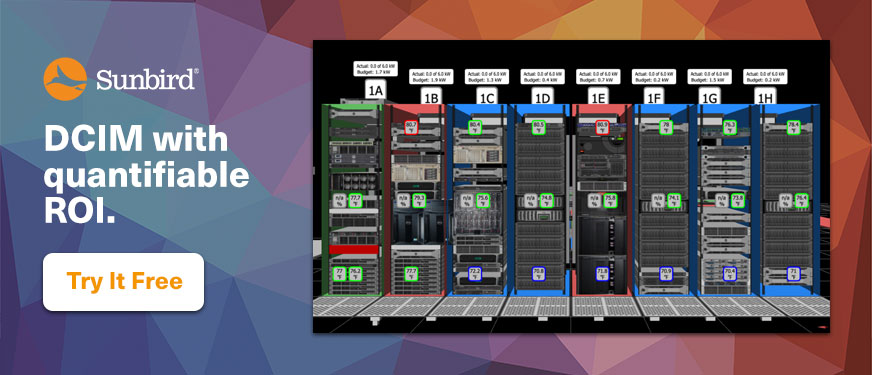5 DCIM Software Success Stories as Told by Real Customers
Managing a data center is not easy.
Today’s data center professionals must maintain uptime, increase the efficiency of capacity utilization, and boost the productivity of people in more complex and more distributed environments than ever before.
Legacy management tools like Excel, Visio, and homegrown systems no longer get the job done for the modern data center. They are hard to use, difficult to maintain, time-consuming, and error-prone.
First-generation Data Center Infrastructure Management (DCIM) software vendors marketed their products as a panacea to all data center problems, but their overhyped products did not deliver as promised. Because of the failures of these legacy DCIM products, some data center professionals still hold the belief that DCIM software is just smoke and mirrors.
However, the emergence of second-generation DCIM has changed everything, fulfilling the promises left unkept by first-generation counterparts. Innovative data center professionals are realizing the enormous potential of modern DCIM software and report high satisfaction ratings and fast ROI.
Let’s explore five real-world stories of how modern data center managers are dramatically simplifying data center management with DCIM software.
1. Comcast unlocked 40% more capacity out of their facilities and power resources.
Comcast is one of the largest internet service providers and cable companies in the US with 1,600 data center locations.
At their colocation sites, Comcast pays for power and space upfront. They realized that they would be able to significantly reduce operating expenses by finding space and power resources that were not being leveraged to their full potential.
To achieve this, they use their DCIM tool to monitor and measure power usage at the device level in real time. They can understand power utilization trends and capacity levels across their facilities’ entire power paths including building meters, UPSs, floor PDUs, RPPs, busways, and rack PDUs.
Then, Comcast uses the Auto Power Budget feature of their DCIM to automatically calculate an accurate power budget number for each make and model instance of their devices based on the actual measured loads of their devices in their environments running their applications.
This enables Comcast to find stranded power capacity and know the exact locations where assets can best take advantage of the available power to get the most out of their existing resources.
“From an ROI perspective, it’s massive for us. We’re getting 40% more usage out of our facilities and power sources,” said Michael Piers, Senior Manager DCIM/Tools, Comcast.
“It’s a big win to be able to see where we have space, as well as where we have more power that can be used by devices,” said Piers. “[We know] exactly where assets should be connected, how they should be connected, what downstream devices are impacted, and how much power those pieces and parts will use.”
In addition to their cost savings due to automating device power budgeting, Comcast reports “huge time savings with regards to deployment and managing our data center.”
Read the complete Comcast case study.
2. Workday automated provisioning, orchestration, and more.
Workday is a leading provider of enterprise cloud applications for finance, HR, and planning designed for the world’s largest companies, educational institutions, and government agencies.
Workday uses the bidirectional RESTful web service API of their DCIM tool to automate just about everything in their data center operations. Here’s one example in which they automated provisioning and orchestration.
Before they deployed DCIM, Workday had a homegrown tool that they had begun integrating with other systems. Right away, they learned that unless they were able to do this in near real-time, they were going to have data integrity issues where their asset tool could report values that weren’t accurate until a machine configuration was complete. This had the potential to create issues with operations, compliance, and credibility. To overcome this challenge, Workday created the concept of a “source of becoming,” similar to the well-known “source of truth.”
“We realized we needed a way to track both,” said Tony Lincoln, Principal DevOps Engineer, Workday. “The solution for us was to leverage the custom fields capability that dcTrack has natively.”
Instead of using a standalone database to capture these desired values, Workday captures data for both desired values and reported values within their DCIM. Then, they use those desired values as integration points for our provisioning and orchestration tooling.
“dcTrack plays a critical role in providing both information about the way things are and the way we want them to be,” said Tony Lincoln, Principal DevOps Engineer, Workday. “We use DCIM lookups to determine which racks and hosts are ready to build based on their attributes. We write back to DCIM about the state of the given device as it moves through its lifecycle. Then, service teams can rely on DCIM to show which racks are ready to use.”
Workday’s automation capabilities, which also include virtual machine data management, device state tracking, and parts management, have earned them great recognition within the organization.
“Several years in, DCIM is a mature service here at Workday and contains a wealth of information that the business uses,” said Lincoln. “We had a business analyst who recently saw all our data and called DCIM ‘the hub’ for asset data for our organization.”
Watch Workday explain how they drive automation via integration.
3. Merck moved off spreadsheets to manage their parts and spares.
Merck is a multinational pharmaceutical company ranked 71st on the 2022 Fortune 500 list.
Like many organizations, Merck used to use Excel spreadsheets to track their data center assets and parts inventory.
According to Jeff Carlton, CTC Data Center Engineer/DCIM Global Data Center Engineering, Merck, this is “the old way of tracking our inventory at several different sites all managed by different people and different teams.”
“We typically had two sections of our spreadsheets: the assets section and the parts section,” said Carlton. “When we brought on DCIM, the assets section got taken care of with dcTrack, but the parts were still a problem and remained within the spreadsheets. This comprised of our memory, hard drives, power supplies, SFPs, and PCI cards.”
When their DCIM vendor introduced a Parts Management feature, Merck was an early adopter, eager to resolve their pain points of manually managing multiple spreadsheets. They began by building their own parts library with customizable parts templates based on the data they already had on their spreadsheets. They also used custom fields to track any attribute about their parts that they wanted.
By configuring thresholds on parts counts and enabling alerts so they are notified when thresholds are violated, Merck knows exactly when they are running low on a certain part and need to resupply.
“We were able to take our list off our spreadsheets and generate the standardized library of all our different parts models,” said Carlton. “Taking that data and applying it to the actual list, we’re generating a large inventory of over 500 parts now between two data centers.”
Finally, Merck can search, sort, and export an audit log of all their parts transactions to know everything that’s happening with their parts.
“Looking at the transaction for a part, we’re able to keep up with who is consuming them for a project. It allows us to keep track of what’s going on and align part usage better than what we had seen using a spreadsheet,” said Carlton.
Watch Merck explain how they manage parts.
4. Vodafone dramatically increased their data center sustainability.
Vodafone is a telecommunications company that’s trusted by more than 300 million mobile customers, 28 million fixed network customers, 22 million television customers, and 6 million business customers around the world.
Vodafone has sustainability goals to reduce the carbon footprint of their data centers. They needed powerful and reliable DCIM software that would enable them to increase their energy efficiency and maximize the utilization of their existing facilities to defer building new ones.
“Sunbird provides the ability to measure, monitor, and document what is actually happening in our data centers. Then, we can implement things to keep the costs down,” said Andrew Marsh, Senior Manager for Infrastructure and Data Centers, Vodafone United Kingdom. “We can actually measure the individual temperatures in a cold aisle so we can see the Delta T. That allows us to raise the temperatures in the cold aisle which saves us a large amount of money.”
Second-generation DCIM also allows Vodafone to plan and manage their power, space, and cooling capacity more efficiently. By instantly finding available capacity, they can make smarter and faster deployment and management decisions.
“Because we’re getting real power readings, we don’t have to go off of the device nameplate ratings,“ said Marsh. “We’re getting better densification in our data centers which prevents us from having to build more facilities. In one room, we were able to do a 4-1 server consolidation exercise so we’re saving 75% power. It’s only by measuring things using Sunbird that we’re able to do that.”
Vodafone has a small data center team, but with their DCIM software, they are able to keep up with demand, deploying 200-300 servers every couple of months.
“The solution is very intuitive, and support is always there when we need it,” said Marsh.
Read the complete Vodafone case study.
5. UF Health increased their asset tracking efficiency by 50%.
University of Florida Health (UF Health) is a premier health system with over 10,000 employees that serves communities in the southeast United States. It includes teaching hospitals, specialty hospitals, outpatient rehabilitation centers, home health agencies, and emergency rooms.
Before deploying DCIM software, UF Health used Excel spreadsheets and Visio diagrams to track their data center assets. When they became responsible for three more data centers, they realized that they would need a new tool to help answer what equipment was in each data center, exactly where each device was located, and what was connected to what.
“Before we deployed dcTrack, it would mean a trip out onto the data center floor to confirm or deny that a server is in a certain location,” said Joe Keena, Manager Data Center Operations, UF Health. “Now, we can just pull up the asset information on the dcTrack screen and see that server X is located in this rack, in this U, or see that it is no longer a physical server but is now a virtual server. Accurate asset records have given us a 50% gain in efficiency in terms of locating an asset’s physical location within the data centers.”
Other results UF Health have achieved with DCIM software include measuring Power Usage Effectiveness (PUE), troubleshooting and preventing problems more easily, performing moves, adds, and changes more efficiently, and projecting when they will run out of capacity to improve planning.
“We’ll have a much more fluid and up-to-minute picture of our capacities in terms of power, space, and cooling and be able to provide that information on a regular basis to management to say, ‘Here’s how we’re situated’ and ‘Here’s how we’ve been trending.’”
Read the complete UF Health case study.
Conclusion
Some of the largest and most sophisticated organizations in the world are seeing a serious return on their investment with second-generation DCIM software. The data center managers who championed deploying DCIM software are now superheroes in their organization for improving uptime, increasing efficiency, and boosting productivity.
We hope that their stories have inspired you to consider a modern DCIM tool to dramatically simplify how you manage your data center. Partner with a vendor that is focused on your success, and you will reap the same benefits.
Want to read even more real-world DCIM success stories? Download our new eBook Top 10 DCIM Software Customer Success Stories or check out our collection of DCIM case studies.
Heard enough and want to try Sunbird’s second-generation DCIM software yourself? Get your free test drive today.































